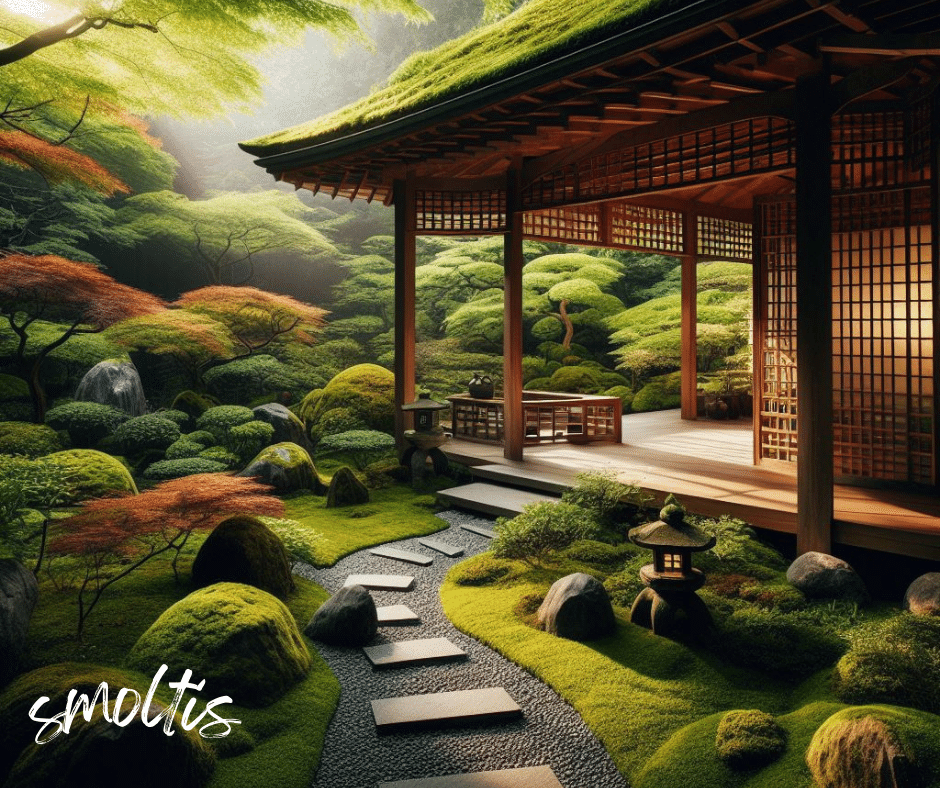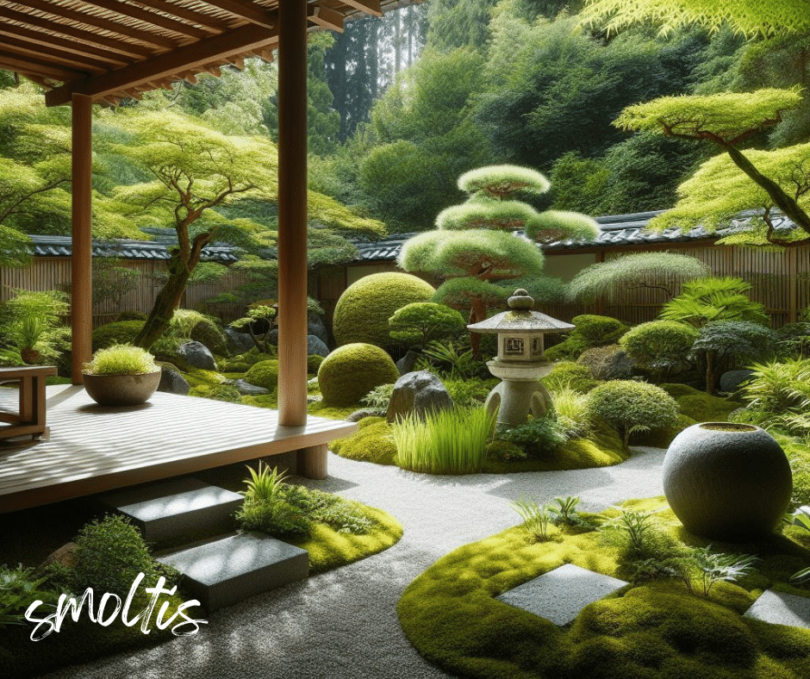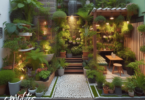Transform your outdoor space into a tranquil retreat with Japanese-inspired shade gardens. These Zen designs create calming home decor and serene living spaces, allowing you to escape the stress of everyday life and find relaxation right in your backyard.

Key Takeaways
- Create a calming home decor with Japanese-inspired shade gardens
- Design serene living spaces that promote tranquility
- Turn your backyard into a relaxation retreat at home
- Incorporate Zen principles and elements into your garden design
- Select purposeful plantings to create a serene oasis
Embracing the Essence of Zen
To achieve tranquility in your backyard, it is essential to embrace the essence of Zen. The principles of Zen design can be incorporated into your shade garden to create a sense of peace and harmony.
Zen, deeply rooted in Japanese culture, is a philosophy that seeks to cultivate mindfulness and inner peace. It emphasizes simplicity, balance, and connection with nature. By adopting Zen principles in your garden, you can create a tranquil space that promotes relaxation and serenity.
Balance and Simplicity
One of the key principles of Zen design is balance. This involves arranging elements in a way that achieves visual harmony. In a shade garden, you can create balance by combining different textures, colors, and heights. For example, pairing delicate ferns with bold rocks or placing a small waterfall next to a peaceful meditation area creates a sense of equilibrium.
Simplicity is another fundamental aspect of Zen design. It involves removing unnecessary clutter and focusing on essential elements. In a shade garden, this can be achieved by selecting a few focal points, such as a beautifully pruned bonsai tree or a carefully placed stone lantern. Avoid overloading the garden with too many intricate details that can disrupt the feeling of tranquility.
Natural Materials
Incorporating natural materials is crucial to creating an authentic Zen garden. Choose materials like bamboo, gravel, and timber to bring a sense of harmony and connection with nature. These materials not only add to the aesthetic appeal but also evoke a feeling of grounding and earthiness.
Bamboo can be used to create privacy screens or fencing, while gravel or pebble pathways can guide your steps and facilitate mindful walking. Timber can be incorporated through the use of wooden benches or decking, providing a serene seating area where you can relax and enjoy the beauty of your shade garden.
Mindful Arrangement
The arrangement of plants and objects in a Zen garden is intentional and meaningful. Each element is thoughtfully placed to create a harmonious composition. When designing your shade garden, consider the principles of Feng Shui, a complementary practice to Zen, to guide your arrangement decisions.
Balance the yin and yang energies by placing taller, more upright plants on one side and low-lying, spreading plants on the other. Create a sense of flow by arranging plants in a way that leads the eye through the garden. Incorporate natural stone accents to add dimension and texture. Remember to leave space for empty areas, symbolizing tranquility and allowing for contemplation.
Quote:
“In the midst of chaos, find simplicity.” – Albert Einstein
| Elements of Zen Design | Description |
|---|---|
| Balance and Simplicity | Arranging elements to achieve visual harmony and removing unnecessary clutter to maintain simplicity. |
| Natural Materials | Incorporating bamboo, gravel, timber, and other natural materials to create a sense of connection with nature. |
| Mindful Arrangement | Intentionally arranging plants and objects to create a harmonious composition that promotes tranquility. |
Creating a Serene Oasis with Purposeful Plantings
One of the key elements in designing a Japanese-inspired shade garden is the careful selection and arrangement of plants and foliage. By choosing the right combination and placing them purposefully, you can create a serene oasis that evokes tranquility and relaxation.
The first step in creating your serene oasis is to familiarize yourself with the different types of plants commonly used in Zen designs for tranquility. These plants typically include evergreen trees, shrubs, and grasses that provide a sense of year-round greenery and stability. Delicate flowers, such as cherry blossoms or peonies, can add subtle pops of color.
When selecting plants, it’s important to consider their suitability for shade and the specific conditions of your garden. Look for varieties that thrive in low light and have a calming effect. Add texture to your oasis by incorporating plants with varying leaf shapes and sizes, creating a harmonious balance in the overall design.
Arrange your plants in a purposeful manner to enhance the Zen aesthetic. Aim for symmetry and balance, reflecting the principles of harmony and tranquility. Utilize natural groupings to mimic the organic patterns found in nature, creating a sense of peace and unity.
In a Japanese-inspired shade garden, rocks are often incorporated as elements of the landscape. These rocks can be strategically placed to create visually appealing focal points and add a sense of solidity to the garden. Consider using moss-covered rocks or small boulders to simulate the feeling of age and timelessness.
| Plant | Description | Usage |
|---|---|---|
| Japanese Maple | A small tree with delicate, colorful foliage. | Use as a focal point or to add height and elegance. |
| Ferns | Lush, green foliage that thrives in shade. | Plant in clusters to create a lush, ground-covering effect. |
| Bamboo | Tall, slender stalks with gentle rustling leaves. | Plant as a screen or to create a vertical element. |
| Moss | A soft, vibrant ground cover that adds texture. | Use to create moss gardens or as a backdrop for other plants. |
Incorporating water elements, such as a small pond or a gently trickling fountain, can further enhance the serene atmosphere of your shade garden. The sound of flowing water adds a soothing ambiance and promotes relaxation and mindfulness.
By combining purposeful plantings, natural elements, and water features, you can create a Japanese-inspired shade garden that serves as a tranquil retreat. It’s important to regularly maintain and care for your oasis to ensure its long-term beauty and harmony.
Harmonizing Water Features and Natural Elements
Enhance the Zen aesthetic in your shade garden by incorporating water features and natural elements such as rocks and pebbles. These elements not only add visual interest but also contribute to the tranquility of your outdoor space.
Water features, such as small ponds or cascading fountains, create a soothing ambience with the gentle sound of flowing water. They serve as focal points in your garden, inviting relaxation and reflection. Strategically place water features in areas where they can be admired from different viewpoints, allowing you to fully appreciate their beauty. Consider surrounding the water feature with lush greenery or ornamental grasses for a harmonious blend of elements.
When selecting rocks and pebbles for your Zen garden, opt for natural colors and textures that complement the surrounding plantings. Use larger rocks to create visual interest and anchor specific areas, while smaller pebbles can be used to line pathways or form decorative patterns. Arrange them in a deliberate manner to evoke a sense of balance and harmony.
“Water is the softest thing, yet it can penetrate mountains and earth. This shows clearly the principle of softness overcoming hardness.” – Lao Tzu
Combining water features and natural elements creates a serene oasis in your shade garden. The flowing water, along with the soothing earthy textures of rocks and pebbles, invites a sense of calm and balance. It encourages contemplation and provides a tranquil space for introspection.
Design Ideas for Harmonizing Water Features and Natural Elements
Here are some design ideas to inspire you in creating a truly tranquil outdoor space:
- Integrate a small waterfall into a rocky slope, allowing the water to cascade gently into a pool below.
- Place stepping stones across a shallow pond for a unique and meditative pathway.
- Build a dry riverbed with smooth river stones, mimicking the natural flow of water.
- Create a Zen rock garden with an arrangement of rocks and gravel, representing mountains and rivers.
By harmonizing water features and natural elements in your shade garden, you can cultivate a peaceful and serene atmosphere that promotes relaxation and tranquility. The combination of flowing water and earthy textures brings the principles of Zen design to life, creating a truly serene outdoor retreat.
| Water Features | Natural Elements |
|---|---|
| Small ponds | Larger rocks |
| Cascading fountains | Smaller pebbles |
| Waterfalls | Smooth river stones |
Mindful Pathways and Meditation Spaces
Creating mindful pathways and meditation spaces within your shade garden can further enhance the tranquil atmosphere and promote a sense of serenity. These dedicated areas provide opportunities for reflection and contemplation, allowing you to fully immerse yourself in the peacefulness of your outdoor retreat.
Mindful Pathways
Designing mindful pathways in your shade garden encourages a sense of mindfulness and intentional movement. Use natural materials, such as stepping stones or gravel, to create a visually appealing path that guides you through the garden. Consider incorporating curves and gentle turns to evoke a sense of discovery and exploration. Position plants and foliage strategically along the pathway to enhance the calming ambiance and create a harmonious connection with nature.
Meditation Spaces
Designating specific areas in your shade garden as meditation spaces allows you to have a dedicated spot for quiet contemplation and relaxation. Choose a secluded corner or a cozy nook under a tree where you can set up a comfortable seating arrangement, such as a cushioned bench or a meditation cushion. Surround the space with plants known for their calming properties, such as lavender or jasmine, to create an atmosphere conducive to deep relaxation and inner peace.
“In the midst of movement and chaos, keep stillness inside of you.” – Deepak Chopra
These meditation spaces provide an opportunity to escape the noise and distractions of daily life, allowing you to engage in a mindful practice and connect with your inner self. By immersing yourself in a serene and tranquil environment, you can experience a deeper level of relaxation and rejuvenation.
Whether you choose to walk mindfully along the peaceful pathways or find solace and stillness in a meditation space, incorporating these elements into your shade garden will enhance the overall tranquility of your outdoor retreat.
| Benefits of Mindful Pathways and Meditation Spaces | Examples of Materials and Plantings |
|---|---|
| Promotes relaxation and stress reliefEncourages mindfulness and inner peaceFosters a deeper connection with nature | Stepping stonesGravel or crushed stoneDwarf evergreen shrubsMoss or moss-like ground covers |
| Provides a dedicated space for quiet contemplationEncourages a break from technology and distractionsSupports a consistent meditation practice | Cushioned bench or meditation cushionShade-loving plants with soothing scentsFerns or ornamental grasses for privacyBamboo or wind chimes for natural sounds |
Enhancing Zen Designs with Calming Decor
When creating a zen-inspired outdoor space, it’s essential to pay attention to the details of the decor. By incorporating calming decor elements, you can enhance the tranquility and serenity of your living spaces, transforming them into a relaxation retreat at home.
1. Minimalist Furniture
Opt for minimalist furniture designs that are clean, sleek, and uncluttered. Choose pieces made from natural materials such as wood or bamboo to maintain the organic aesthetic of a zen garden. Keep the furniture arrangement simple and spacious, allowing for easy movement and a sense of calmness.
2. Soft Lighting
Soft, ambient lighting is crucial for creating a soothing atmosphere in your outdoor space. Use warm, gentle lighting fixtures strategically placed to highlight specific areas or features of your garden. Consider adding lanterns, string lights, or pathway lighting to create a magical and serene effect as the sun sets.
3. Natural Materials
Bring the calming elements of nature into your zen garden through the use of natural materials. Incorporate stone, gravel, and wood in pathways, stepping stones, or seating areas. Choose materials that age gracefully and blend harmoniously with the surrounding greenery.
4. Soothing Colors
Select a color palette inspired by nature to promote tranquility in your outdoor space. Soft greens, muted blues, and earthy tones create a calming effect and harmonize with the surrounding foliage. Use these colors in your furniture, cushions, outdoor rugs, and decorative accessories.
5. Organic Textures
Add depth and tactile interest to your zen garden with organic textures. Incorporate textured fabrics, such as linen or cotton, in your outdoor cushions and rugs. Introduce natural textures through decorative items like woven baskets, ceramic pottery, or rattan accents.
“By enhancing your zen designs with calming decor, you can create a serene living space that invites relaxation and mindfulness.”
6. Tranquil Water Features
A water feature can add a sense of tranquility and balance to your zen garden. Consider installing a small fountain, a reflection pool, or a flowing stream. The gentle sound of water can create a peaceful ambiance and serve as a focal point for meditation and contemplation.
7. Zen-Inspired Sculptures
Introduce zen-inspired sculptures or art pieces that reflect the aesthetic of your garden. Choose sculptures made from natural materials, such as stone or metal, that complement the serene environment. These sculptures can add visual interest and reinforce the zen atmosphere of your outdoor space.
By incorporating calming decor elements into your zen-inspired shade garden, you can create serene living spaces that promote relaxation and mindfulness. From minimalist furniture to soothing colors and natural materials, every aspect of the decor contributes to the overall tranquility of your outdoor retreat.
Conclusion
By incorporating Japanese-inspired shade garden ideas and Zen designs for tranquility, you have the power to transform your backyard into a serene and peaceful oasis. Embracing the principles of Zen will guide you towards creating a harmonious outdoor space where you can find solace and relaxation.
Be mindful in selecting the right plants and natural elements that evoke tranquility, carefully arranging them to create purposeful plantings that enhance the Zen aesthetic. Integrate water features and rocks, harmonizing them with the surrounding environment to deepen the sense of calmness and balance.
Remember to create pathways and dedicated meditation spaces, offering opportunities for reflection and contemplation amidst the soothing surroundings. By infusing calming decor elements, such as minimalist furniture, soft lighting, and natural materials, you can further elevate your serene living space, promoting relaxation and mindfulness in your everyday life.
FAQ
How can Japanese-inspired shade gardens bring tranquility to my outdoor space?
Japanese-inspired shade gardens incorporate Zen designs and principles that promote peace and harmony. By creating a serene and calming environment, these gardens offer a tranquil retreat where you can relax and find inner peace.
What are the principles of Zen design?
Zen design principles revolve around simplicity, natural elements, and balance. It aims to create a space that promotes mindfulness and contemplation. By incorporating these principles into your shade garden, you can achieve a sense of tranquility and harmony.
What types of plants work well in Japanese-inspired shade gardens?
Common plants used in Japanese-inspired shade gardens include mosses, ferns, hostas, azaleas, and Japanese maples. These plants thrive in shaded areas and have a lush and calming appearance, adding to the sense of tranquility in your garden.
How can I incorporate water features and natural elements into my shade garden?
Water features like small ponds, bamboo fountains, or stone water basins can be added to your shade garden to create a soothing soundscape. Natural elements, such as rocks, pebbles, and stepping stones, can be strategically placed to create a harmonious and balanced design.
How do I create mindful pathways and meditation spaces in my shade garden?
Mindful pathways can be created by using stepping stones or gravel paths that wind through your garden. Meditation spaces can be as simple as a secluded corner with a bench or a small Zen garden with raked sand and stones. These areas provide opportunities for reflection and relaxation.
How can I enhance my Zen designs with calming decor?
Enhance your Zen designs by incorporating calming decor elements such as minimalist furniture, soft lighting, natural materials like bamboo or rattan, and soothing colors like neutrals or pastels. These additions will create serene living spaces that promote relaxation and mindfulness.







